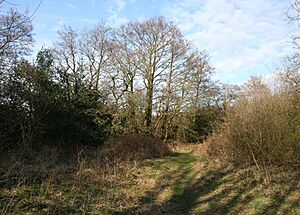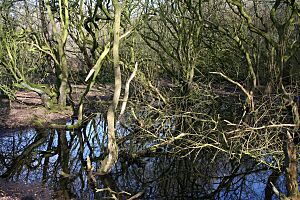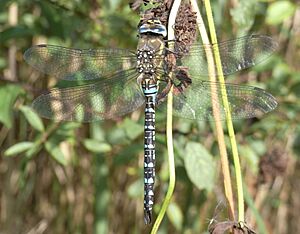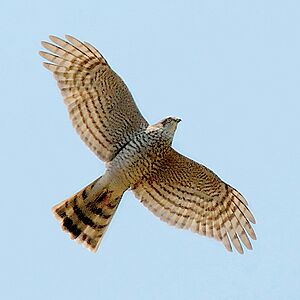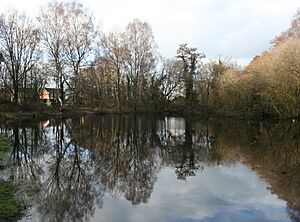Sound Heath facts for kids
| Site of Special Scientific Interest | |
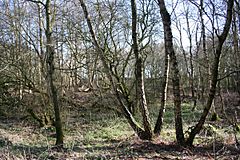
Damp woodland is a common habitat at Sound Heath
|
|
| Area of Search | Cheshire |
|---|---|
| Grid reference | , |
| Coordinates | 53°01′37″N 2°34′01″W / 53.027°N 2.567°W |
| Interest | Biological |
| Area | 4.8 ha (12 acres) |
| Notification | 1963 |
Sound Heath, also called Sound Common, is a special natural area in Cheshire, England. It has many different habitats like heathland, grassy fields, bushes, woods, and wet areas. Most of Sound Heath is protected as a Site of Special Scientific Interest (SSSI) and a Local Nature Reserve (LNR). This means it's a very important place for nature.
Sound Heath is one of the few lowland heaths in Cheshire. A lowland heath is a type of open land with small shrubs, usually found below 300 meters (about 984 feet). It's a great home for many heathland plants and animals. However, trees and bushes are growing quickly, which threatens the open heathland. The ponds at Sound Heath are also super important for tiny creatures that live in fresh water, called invertebrates.
Scientists have found some very rare or endangered species here. These include the mud snail, which is one of the most endangered freshwater creatures in the UK. The great raft spider and a special type of water scavenger beetle called Enochrus isotae also live here. You might also spot the beautiful snout moth, which is rare across the country. The migrant hawker dragonfly was first seen in Cheshire at Sound Heath. Many other local rare species have been recorded here too. The site is also a key place for birds to breed and raise their young.
Contents
Exploring Sound Heath's Location and Land
Sound Heath is located on the Cheshire Plain, about 3 miles (5 km) southwest of Nantwich. It sits at an average height of about 65 meters (213 feet) above sea level. The ground beneath is made of Keuper marl, a red sandstone from the Triassic period. Over time, glacial sand was left behind, creating light, sandy soil that doesn't have many nutrients. People used to dig for sand here, which created many small pools of water.
The Site of Special Scientific Interest (SSSI) at Sound Heath was officially named in 1963. It covers 4.80 hectares (about 11.86 acres). The Local Nature Reserve (LNR), known as Sound Common, was named in 1992. It's a bit smaller, at 4.61 hectares (about 11.39 acres). Both the SSSI and LNR include two separate areas. The larger part is about 3.84 hectares (9.5 acres). A smaller area, about 0.96 hectares (2.4 acres), is also part of it.
The entire common land area is even bigger. It includes the SSSI/LNR sites and other nearby areas. This land is open for everyone to visit and enjoy, thanks to the Countryside and Rights of Way Act 2000.
Different Habitats at Sound Heath
Sound Heath is home to several different types of habitats. These include damp and dry heathland, grassland, scrub (areas with bushes), and young woodland. You'll also find many ponds and wet spots scattered throughout the area. Some ponds are always there, while others appear only during wet seasons.
Heathland and Grassy Areas
Lowland heath is a very rare habitat around the world, and it's especially rare in Cheshire. In 1995, surveys found only about 60 hectares (148 acres) of lowland heath in the entire county. Sound Heath is one of only four lowland heath SSSIs in Cheshire.
In the damp heath areas, you'll find plants like common heather, cross-leaved heath, and common gorse. You might also see purple moor grass and bog moss. Over 50 types of bryophytes (small, non-flowering plants like mosses) have been found here, including the large white-moss, which is rare in Cheshire. Other rare plants seen here include bog asphodel and round-leaved sundew.
The drier heath areas are more grassy. Here, you'll find plants like matgrass and wavy hair-grass. Other plants like common tormentil and heath bedstraw also grow here. The locally rare bird's-foot and shepherd's cress have also been recorded.
Sadly, over the last 40 years, the heathland has shrunk. Bushes and trees like birch, alder, and willow have grown into the open areas. This has made the heath drier, causing some wet heath plants, like bog asphodel and round-leaved sundew, to disappear.
Wetland Habitats and Ponds
The wetland areas at Sound Heath are very diverse. They range from tiny ponds and damp hollows to Sound Pond, which is almost 60 meters (about 197 feet) long. You can find these water bodies in sunny open heath areas and deep within the woodland. These pools were formed when people dug out sand, so they are different from other types of ponds in Cheshire. Most of them are now in a mature stage, meaning they have developed rich ecosystems.
Even though some ponds are filling up with leaves from nearby trees, creating fewer permanent pools, the wet areas that appear seasonally are still important. They support several rare plant species.
The pools are home to many emergent plants (plants that grow in water but stick out above the surface). The rarest of these is bog St John's-wort, which was once thought to have disappeared from Cheshire. The locally rare floating club rush has also been found here. Other wetland plants include bogbean, marsh marigold, and water violet.
Scrub and Woodland Areas
Most of the woodland at Sound Heath is quite new, growing in the last 40 years. However, there are some older oak trees and other mature trees. The main tree species are common alder, pedunculate oak, silver birch, and willow. In the undergrowth, you'll mostly find common bramble.
Animals of Sound Heath
Invertebrates: Tiny Pond Dwellers
The mature ponds at Sound Heath are one of the most important places in Cheshire for freshwater invertebrates. Many rare or endangered species have been found in these ponds. These include the mud snail, the Enochrus isotae species of water scavenger beetle, and the great raft spider. Locally rare pond creatures include the caseless caddisfly and the diving beetle.
Dragonflies and damselflies are very common here, with 15 different species recorded. Two-thirds of these species are known to breed at Sound Heath. You might see the broad-bodied chaser, common hawker, emperor, and ruddy darter. The migrant hawker was first spotted in Cheshire at this very site!
The beautiful snout moth, a rare moth in the UK, has been recorded here. Sadly, the open heath and grassland are no longer a breeding ground for the small heath butterfly, whose numbers are declining in the UK. Sixty different species of spider have also been found at Sound Heath.
Birds: Feathered Friends
Sound Heath is a vital breeding ground for many types of birds. Locally rare species include the Eurasian sparrowhawk and the willow tit. Other birds you might see here are the moorhen, reed bunting, turtle dove, and willow warbler. You could also spot tawny, little, and barn owls, as well as the greater spotted, lesser spotted, and green woodpeckers.
Other Animals: Reptiles and Amphibians
The heathland is an important home for the common lizard. You might also see grass snakes and slowworms in the grassy areas, especially in spring. The ponds are home to the common newt, common toad, and common frog. The large number of insects near the water attracts bats, such as the common pipistrelle and common long-eared bat.
Caring for Sound Heath
Sound Heath is looked after by the Cheshire Countryside Management Service and volunteers from the Sound and District Residents Association (SADRA). SADRA was started in 2000 to help with conservation work at the common. The land is owned by the Cheshire East council.
The management team works hard to keep the heath healthy. They clear away bushes and brambles, remove young trees, thin out gorse, and remove New Zealand pondweed from Sound Pond. They also maintain footpaths and bridges and remove any rubbish. In 2003, heather seeds from another special site, Little Budworth Common, were planted here to help the heath grow back.
In 2002/3, a group called English Nature suggested removing older trees from the edges of open areas to help the heathland grow. However, SADRA believes Sound Heath is a "Mosaic" site. This means it has many different habitats, and no one part should be expanded if it harms another part. So, they have been careful with tree removal, only cutting trees where it clearly helps the site.
In 2008, Natural England said the site was in an "unfavourable but stable condition." This was because the growth of trees and bushes had reduced the number of heathland plants. Other problems for the area include illegal dumping of trash, algal blooms in the ponds, and issues like fishing, camping, and lighting fires around Sound Pond.
For visitors, there's a car park on Sound Lane and a sign that tells you more about the common's ponds.


